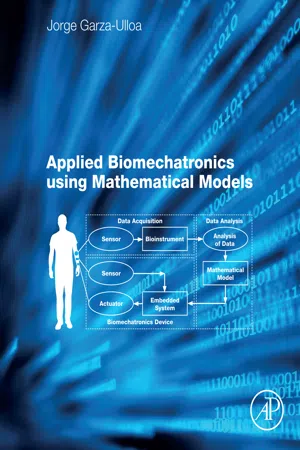
- 662 pages
- English
- ePUB (mobile friendly)
- Available on iOS & Android
Applied Biomechatronics Using Mathematical Models
About This Book
Applied Biomechatronics Using Mathematical Models provides an appropriate methodology to detect and measure diseases and injuries relating to human kinematics and kinetics. It features mathematical models that, when applied to engineering principles and techniques in the medical field, can be used in assistive devices that work with bodily signals. The use of data in the kinematics and kinetics analysis of the human body, including musculoskeletal kinetics and joints and their relationship to the central nervous system (CNS) is covered, helping users understand how the complex network of symbiotic systems in the skeletal and muscular system work together to allow movement controlled by the CNS.
With the use of appropriate electronic sensors at specific areas connected to bio-instruments, we can obtain enough information to create a mathematical model for assistive devices by analyzing the kinematics and kinetics of the human body. The mathematical models developed in this book can provide more effective devices for use in aiding and improving the function of the body in relation to a variety of injuries and diseases.
- Focuses on the mathematical modeling of human kinematics and kinetics
- Teaches users how to obtain faster results with these mathematical models
- Includes a companion website with additional content that presents MATLAB examples
Frequently asked questions
Information
Introduction to biomechatronics/biomedical engineering
Abstract
Keywords
1.0. Introduction
1.1. The Evolution From Basic Disciplines of Engineering to Multidisciplinary Engineering Branches
- • Chemical Engineering: defined as the application of physics, chemistry, biology in order to carry chemical processes on commercial scale, as petroleum refining, microfabrication, fermentation, and biomedical production.
- • Civil Engineering: covers the design and construction of private and public works, such as infrastructures (airports, roads, railways, water supply and treatment, etc.), bridges, dams, and buildings.
- • Electrical Engineering: for the design, study and manufacture of electric and electronic systems, which include electrical circuits, generators, motors, electromagnetic/electromechanical devices, electronic devices, electronic circuits, optical fibers, optoelectronics devices, computer systems, etc.
- • Mechanical Engineering: for the design, study, and manufacture of physical/mechanical systems. To create from products such as engines, compressors, power trains, kinematic chains, vacuums, and many more.
- • Mechanics evolved to Mechanical engineering: Mechanics studies the physical bodies when subjects to forces and displacement, dealing with physical energy and forces and their effects on objects. And, Mechanical engineering comprises the design, analysis and usage of heat and mechanical power for the operation of machines and mechanical systems. Today Mechanical engineering deals with a very vast field and encompasses various aspects and interdisciplinary including but not limited to power generation, manufacturing, aerospace, transportation, vehicle, energy, and so forth.
- • Mathematics evolved to Mathematical Engineering: Mathematics studies the measurements, properties and relationships of quantities and sets, using numbers and symbols. The major divisions of Mathema...
Table of contents
- Cover
- Title page
- Table of Contents
- Copyright
- Applied Biomechatronics Using Mathematical Models
- Dedication
- Thanks
- About the Author
- Preface
- Chapter 1: Introduction to biomechatronics/biomedical engineering
- Chapter 2: Introduction to human neuromusculoskeletal systems
- Chapter 3: Kinematic and kinetic measurements of human body
- Chapter 4: Experiment design, data acquisition and signal processing
- Chapter 5: Methods to develop mathematical models: traditional statistical analysis
- Chapter 6: Application of mathematical models in biomechatronics: artificial intelligence and time-frequency analysis
- Chapter 7: Case studies of applied Biomechatronics solutions based on mathematical models
- Index